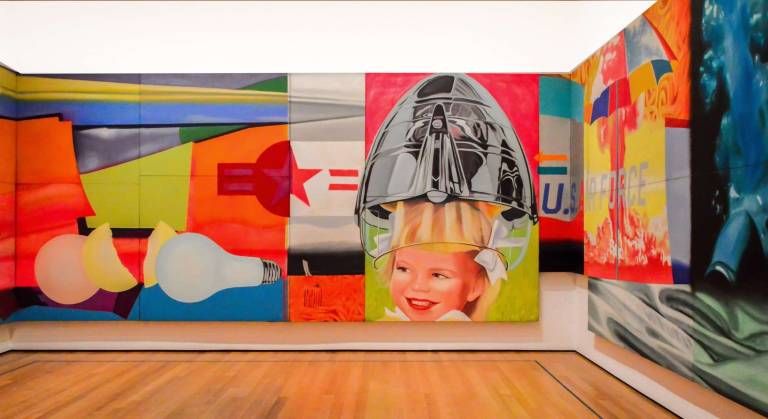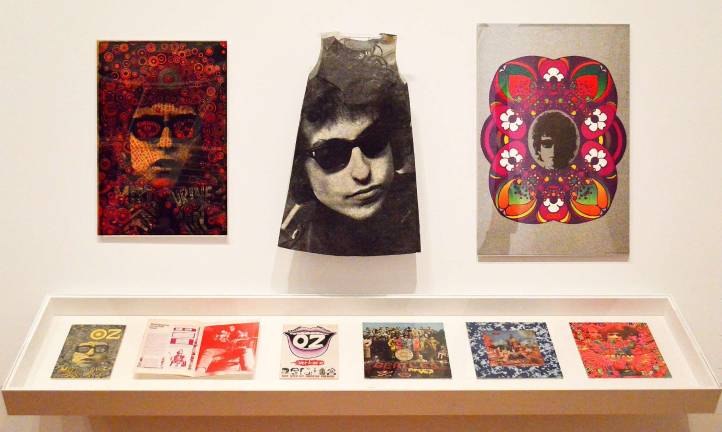MoMA’s Brief History of Time






BY MARY GREGORY
Interested in how, when and why New York came to be the capital of the art world? (And yes, it still is. Sorry, London.) MoMA’s curators have stirred the pot again, to delightful results, installing, on the fifth floor, a selection that brings across the development of the New York art scene in the 1940s and ‘50s. It’s followed by a bursting-at-the-seams overview of the 1960s that fills the entire fourth floor with iconic, signature works.
The story of how it all started is not immediately obvious, and that’s a good thing. Other than selfies, the whole reason we go to museums is to consider, learn, reflect and have things revealed, gradually and wondrously. The first piece in the show is a charming painting by William H. Johnson, an African-American painter from South Carolina who worked his way to the National Academy in New York and later to Paris. “Three Girls” (1941) blends elements of realism, abstraction and folk art. It’s easily readable on one level, but hardly hints at the complexities of a life plagued by prejudice both at home and in Europe. His work was declared “degenerate,” and he had to flee Nazi persecution.
Johnson wasn’t the only artist to run from the horrors of World War II. Our shining city welcomed many European artists, art dealers, intellectuals and writers, who, in turn, reinvigorated post-Depression New York. No one could deny the horrors of the war, but in this modern, elegant, free and welcoming city, together, they could face it. Maria Martins’ bronze “The Impossible III” hints at the anguish and terror of those years. Surrealism, expressing an alienated, often torturous alternate reality, seemed to ring true for many. Masters of the style, Roberto Matta and Max Ernst arrived in New York just in time to influence American artists. Between Matta’s dizzying “The Vertigo of Eros” and Ernst’s unsettling “Napoleon in the Wilderness” hangs Dorothea Tanning’s “On Time Off Time.” Tanning holds her own with inexplicable, dreamlike imagery of flames, billowing smoke, halo-like sunflowers and a blindfolded woman all caught within an illogical architecture. Ernst’s influence on her — and hers on him — is hard to deny. They fell in love, married and moved back to Paris together. But not before getting to know the rest of the New York arty, intellectual crowd.
Parties at Peggy Guggenheim’s gallery led to cross-fertilization of already fecund minds. Painters like Jackson Pollock, Lee Krasner, Barnett Newman, Mark Rothko and Philip Guston are all represented in the next gallery with major works of Abstract Expressionism. To the psychological blitz of the war they added their responses, filled with American optimism. The wall texts point out that Rothko wrote in 1947 that “pictures must be miraculous.” Newman spoke of expressing “his connection to others.” Guston’s “Painting” and Rothko’s “No. 3/No. 13” pulsate with an energy that’s palpable and uplifting. Pollock’s masterpiece, “One: Number 31, 1950” vibrates on a frequency that can only be experienced in person.
The following gallery covers the mid-1950s. By then, Pollock and Rothko were already stars. It was time for something newer than new, and Robert Rauschenberg obliged by sticking his whole bed, droopy quilts, pillow and all, up on an easel and painting it. His “Combines” still shock in their unrepentant unconventionality. Cy Twombly, the curators point out, rejected the lofty status of oils and used only humble house paints, crayons and pencils to create his enigmatic, poetry laden art. Together with artists like Jasper Johns and Frank Stella, they ushered out Abstract Expressionism and made room for something completely different.
The Sixties fill the fourth floor. There’s no time here for dawning realizations. Everything happens 1960s style. Big. Brash. Bold. Hallucinogenic. Rocket fast. Warhol riffs on fame and glitz via Marilyn. James Rosenquist’s room-filling “F111” is a mind trip. Even Agnes Martin’s spiritual minimalism is gold-plated.
There’s an entire wall of ‘60s concert posters, across from a life-sized photograph of a Greyhound bus. You can almost hear the twang of Bob Dylan’s guitar at a case filled with artworks inspired by and devoted to him. The Beatles get a wall, too. Social unrest and protest is addressed in — surprisingly — a group of photographs from France. Henri Cartier-Bresson’s striking students and farmers remind us that the search for justice has been played out in marches across decades and continents.
Yet, as much as things never seem to change, certain moments can never be repeated. The final gallery is dedicated to 1969 — the year of the moon — and the impossible to match experience of watching humans walking on the lunar surface. There’s a wall of photographs from NASA, across from Rauschenberg’s homage “Sky Garden.” The final work is smaller than a fingernail. This tiny piece of ceramic, “The Moon Museum,” contains imagery by Rauschenberg (a line), Warhol (a phallic-looking rocket ship), John Chamberlain, Forrest Myers, David Novros and Claes Oldenberg (a Mickey Mouse drawing). It’s part of a series of 12. Myers reported that he snuck one onto the Apollo 12 spaceship and it was left on the moon. You can see it at MoMA, or imagine it next time you’re looking up.